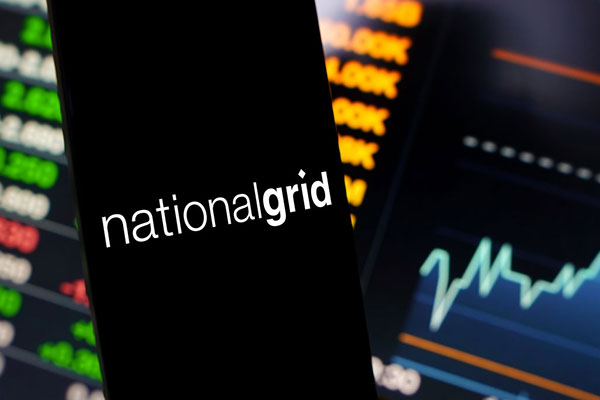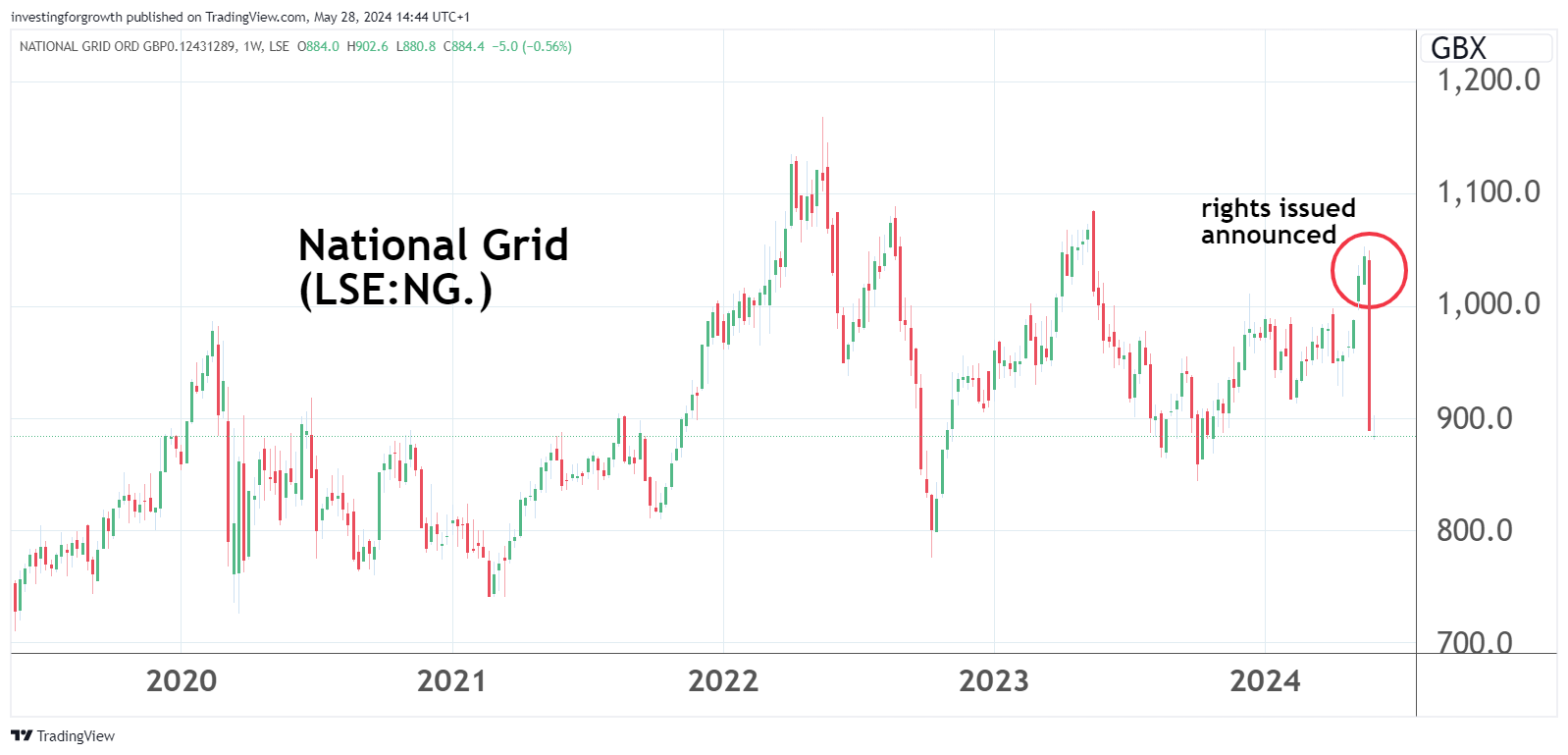National Grid rights issue: all you need to know
We analyse the choices faced by National Grid shareholders following news of a £6.8 billion fundraising, what they must consider and what happens next.
28th May 2024 16:34
by Graeme Evans from interactive investor

More than half a million retail investors have a decision to make in the coming days after National Grid (LSE:NG.) last week unveiled the UK’s biggest rights issue since 2009.
The £6.8 billion fundraising by the FTSE 100-listed energy infrastructure firm involves the offer of seven new shares at a discounted price of 645p for every 24 already held.
- Invest with ii: Top UK Shares | Share Tips & Ideas | Open a Managed ISA
Existing shareholders have four choices: subscribe for the new shares, sell some and buy the rest using the proceeds, sell all the rights, or do nothing and let the rights lapse.
The latest official time for acceptance is 11am on Monday 10 June, with dealings in the new shares set to begin at 8am on Wednesday 12 June. However, interactive investor clients must make their election by 5 June 2024, which is also the last time they will be able to sell the nil-paid rights — the difference in value between the issue price (645p) and ex-rights price, adjusted for the final dividend of 39.12p per share.
The London market’s last high-profile rights issue took place in October 2020, when troubled Rolls-Royce Holdings (LSE:RR.) raised £2 billion by offering 140,000 shareholders 10 new shares for every three already owned. The offer price of 32p a share compares with 450p earlier today.
National Grid’s fundraising is the biggest cash call since the Lloyds Banking Group (LSE:LLOY) rescue rights issue of 2009, when proceeds amounted to £13.5 billion and new shares were issued at 37p.
A year later in 2010, National Grid raised £3.2 billion in preparation for an era of significantly higher capital investment worth £22 billion over five years. The two-for-five rights issue at 335p was the largest amount of equity ever raised by a UK utility.
Over the past decade up to this March, National Grid has delivered a total shareholder return of 211% versus the FTSE 100 index at 172%.
The company is tapping shareholders again in 2024 as part of its pledge to deliver £60 billion of investment in energy network infrastructure in the UK and US between 2024 and 2029. That’s nearly double the amount of the previous five-year period.
National Grid shares have fallen sharply since last Thursday’s surprise results-day announcement, a decline partly driven by technical forces as earnings per share forecasts have been impacted by the issue of so many new shares.
However, Bank of America believes the market reaction gives no credit for the substantial de-risking of the company’s balance sheet and the enhanced earnings visibility through to 2029. It lowered its price target on Friday, but still sees a big upside to 1,170p.

Source: TradingView. Past performance is not a guide to future performance.
What are the details of the rights issue?
To generate anticipated proceeds of £6.8 billion, the company is issuing 1.085 billion new shares. This is equivalent to about 29.2% of its current share capital, or 22.6% of the enlarged issued share capital of 4.807 billion once the fundraising is completed.
The issue price of 645p represents a 34.7% discount to the theoretical ex-rights price, the level that factors in the impact of the new shares. This calculation is based on Wednesday evening’s close of 1,127.5p (adjusted for 2024’s dividend of 39.12p). National Grid shares will trade without the right to the dividend from 6 June and the dividend will be paid on 19 July.
- Sign up to our free newsletter for share, fund and trust ideas, and the latest news and analysis
- 10 hottest ISA shares, funds and trusts: week ended 24 May 2024
Seven new shares are being offered for every 24 held. These rights have a value and can be bought and sold. Shareholders can take up their rights until 10 June, with any outstanding rights taken up by National Grid’s banking partners.
The company had 639,029 shareholders at the end of March, with more than 500,000 having fewer than 500 shares. In many cases their ownership dates back to the London stock market IPO on 11 December 1995. It’s also been a popular stock with income investors, given that the dividend (current yield 6.2%) is protected in real terms through benchmarking against the increase in average annual CPI inflation plus housing costs (CPIH).
What are the four choices for existing National Grid investors?
Subscribe for the new shares, or exercise your rights, which means you have to invest more money in the company. If you have 240 existing shares, for example, you have the right to buy 70 new shares at 645p. By buying all your rights for a total price of £451.50, you now have 310 shares and own the same percentage of the company as you did before the rights issue.
You can choose to sell some of the shares so you can buy the rest with the proceeds. The number of shares you are able to buy will depend on what price people are willing to pay for the rights you are selling. But you will end up owning a smaller percentage of the total shares than you did before the rights issue.
- Stockwatch: is stubborn inflation reason to worry?
- Stock markets at records and cash at 5%: what will happen next?
The third option is to sell all the rights. Again, the price achieved will depend on the price that people are willing to pay for those rights. Using the same example as above, you will have 70 rights shares to sell and still own 240 National Grid shares, but this will be a smaller percentage of the company than before.
Do nothing and let your rights lapse. By doing so you will be diluting your stake in the company, including your entitlement to future dividend payments. If you do this, your rights will be offered for sale to other investors and you will be sent any proceeds by the company’s share registrar (minus expenses).

Why the fundraising?
National Grid is planning a significant increase in capital investment to around £60 billion over the five-year period to 2029. Its financing plan has been designed to enable the company to retain a resilient balance sheet and investment grade credit rating, whilst still enabling a material step-up in investment in the coming years.
About 52% of this expected spend will be in the UK, with the rest in the US. Around 85%, or £51 billion, is “green investment” and 98% of the total in regulated businesses, including around 80% in electricity networks and approximately 10% offshore.
The investment comes as the UK government targets a fully decarbonised electricity system by 2035, with a legal obligation under the Climate Change Act 2008 to achieve net zero by 2050.
- AIM stocks, elections and what to expect after 4 July
- Stockwatch: a buy after strongest numbers this results season?
National Grid owns and operates the regulated high-voltage electricity transmission network in England and Wales as well as the UK’s largest regulated electricity distribution business, which serves nearly eight million customers in the East and West Midlands, South West and Wales.
A legally separate business balances the supply and demand of electricity to homes and businesses in Britain.
Unlike the UK, the company’s gas and electricity businesses in the US supply energy directly to customers in New York and Massachusetts.
In the US, the state of New York is targeting a 100% zero-emission electricity sector by 2040, while Massachusetts has set out a net-zero target by 2050.
What’s the company say?
National Grid describes the rights issue as a pre-emptive opportunity for shareholders to fund and to benefit from its higher-growth strategy.
It believes it is in a position to deliver an “attractive mix” of asset and earnings growth and dividend yield, whilst enabling the energy transition in UK and US markets.
It says: “This builds on our track record of having delivered an over 30% higher total shareholder return compared with the FTSE 100 over the last decade.”
- Insider: heavy buying and selling of these FTSE 100 shares
- Shares for the future: a business I love is in great shape
It has pledged to maintain a progressive total level of dividend, growing from current levels of approximately £2.17 billion for the year to March 2024.
The total dividend will be rebased by about 15% in order to take account of the new shares in issue, with the company then sticking to its policy of growing the payout in line with UK CPIH.
What’s the City view?
Shares have fallen sharply since the announcement, including Thursday’s 11% decline and a further 4% fall on Friday. This partly reflects the dilutive impact of the new shares due to be issued, as well as the planned rebasing of the dividend.
Bank of America also noted potential disappointment that the increased capital expenditure has not meant an improved growth target for earnings per share (EPS) compared with the previous business plan.
It adds that the timing of the announcement was also surprising, coming ahead of industry regulator Ofgem’s initial view on returns on its RIIO-T3 price control period for electricity transmission.
Note: Ofgem’s regulatory framework is known as RIIO (Revenue = Incentives + Innovation + Outputs). As National Grid explains: “The RIIO model offers network companies incentives for innovation and securing investment, so they can develop sustainable energy networks at the lowest cost for current and future customers.”
- How to invest ahead of the general election
- Sector Screener: financially sound stocks with growth potential
Bank of America says: “We believe the market has given no credit for the substantial de-risking of the balance sheet and for enhanced earnings visibility (new outlook to 2029 vs prior outlook to 2026).”
It also notes that the EPS growth targets are likely to have moderate upside due to further capital expenditure upgrades and potentially favourable regulatory outcomes.
The bank has reduced its EPS estimates over 2025-26 by 10-13% to reflect the higher share count, with its new price target of 1,170p down 7.9% from 1,270p previously.
It adds: “We note that the standalone dilution from the rights issue would have implied a 9.8% reduction of equity value per share, which in our model is partly offset by slightly higher value creation in the UK and the US businesses (lower cost of capital) and lower financial expenses.”
These articles are provided for information purposes only. Occasionally, an opinion about whether to buy or sell a specific investment may be provided by third parties. The content is not intended to be a personal recommendation to buy or sell any financial instrument or product, or to adopt any investment strategy as it is not provided based on an assessment of your investing knowledge and experience, your financial situation or your investment objectives. The value of your investments, and the income derived from them, may go down as well as up. You may not get back all the money that you invest. The investments referred to in this article may not be suitable for all investors, and if in doubt, an investor should seek advice from a qualified investment adviser.
Full performance can be found on the company or index summary page on the interactive investor website. Simply click on the company's or index name highlighted in the article.